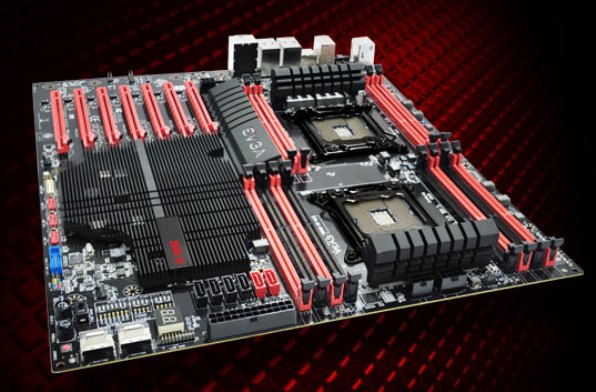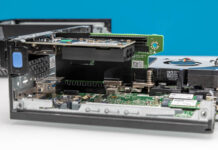Today we take a look at what the EVGA SR-X Classified is all about. The EVGA SR-X Classified is a successor to EVGA’s popular SR-2 motherboard. Brands usually associated with single socket mainstream motherboards (e.g. the Intel LGA 1155 for Sandy Bridge and Ivy Bridge and the AMD Socket AM3+ platform) are now coming out with high-end dual socket motherboards. One thing that has changed for these motherboard makers with the new Intel Xeon Sandy Bridge-EP Xeon family is the inability to get a meaningful overclock from the new Intel Xeon CPUs. Can EVGA put up a good fight against the professionals like Supermicro and Tyan who are workstation and server board specialists? Let’s take a quick look.

Key Features
- Dual Intel Xeon Sandy Bridge-EP E5-2600 series CPU sockets
- Chipset – Intel C606
- SLI – 4-Way
- SATA – Native 3/6
- GSAS – Native 3G
- Memory Support – 12 DIMM Quad-Channel DDR3 1600MHz+ (Up to 96GB)
- PCI-E Slots – 7 PCI-E 3.0 16/8x slots
- Capacitors – 100% POSCAP
- Form Factor – HPTX
- Ethernet – Gigabit Intel NIC
Internal I/O
- 3x USB 2.0 Headers
- 1x USB 3.0 Headers
- 4x SATA 3G Ports
- 2x SATA 6G Ports
- 2x Mini SAS Ports
- 1x 1394b Firewire Header
External I/O
- 4x Rear Panel USB 2.0 Ports
- 6x Rear Panel USB 3.0 Ports
- 8x Channel Audio + Optical
- Dual Intel Gigabit Ethernet
- 2x E-SATA Ports
Other Features
- 300% More Gold Content
- 2×6 Phase PWM
- Onboard Bluetooth
- PCI-E Disable Switches
- E-LEET Tuning Utility Support
- Triple BIOS Support
- EZ Voltage Read Points
- Onboard CPU Temp Monitor
- Passive Chipset Heatsink
- 8+6PIN CPU Power
- 100% POSCAP Capacitors
- DIMM Disable Switches
With those specs from EVGA’s site, let’s look at some of the Pros and Cons with EVGA’s approach to addressing the dual Intel Xeon workstation market.
The Good
The EVGA SR-X Classified has 7x PCIe 16x mechanical slots, 4 way SLi/Crossfire support, but in 4 slots = x16, x16, x8, x8, still lots of PCIe bandwidth thanks to the dual Intel Xeon E5 CPU sockets. In a big upgrade over the SR-2, EVGA includes two 1GbE Intel 82574L based LAN ports, which are widely supported NICs. The SR-X is a very clean looking board, with nice and tidy looking heatsinks, and looks good in black and red. One can see a giant PCH heatsink atop the PCH for good cooling potential. With Quad SLi/Crossfire the EVGA SR-X is an ideal candidate for a Graphics workstation or a CUDA server.
The Intel Patsburg C606 chipset, EVGA included 2x 4-port SAS connectors that are handled by the PCH. These eight PCH ports are only 3Gbps but they will be decent for spinning disk storage. EVGA is including two eSATA III connectors which is nice, but with the Intel Patsburg controller being onboard means that one gets two internal SATA III ports alongside four additional SATA II 3.0gbps 7-pin ports.
Areas with Reservations
Its a real monster of a board, and comes in a new format (to me), HPTX (15×13.6″) which is way bigger than most server boards. Finding a chassis for the SR-X is going to be difficult given its size. Fitting the SR-2 was also an issue. Why EVGA did not use a standard large board size is really strange because it would be easy to stick this in a 4U server chassis if it was a standard size.
On the other hand, with two LGA2011 CPUs and a heap of features including 12 DIMM slots, big is better, but not best if your the only one this big. The maximum memory support is 96GB max RAM, this would most likely be from 12xGB Unbuffered DIMMs, not sure why EVGA don’t advertise Registered and LRDIMM support, unless they don’t support it, but the CPU does. Also, especially if using a larger board size I would have liked to have seen eight or twelve DIMM slots per CPU. 96GB of RAM in a dual CPU setup for Graphics/ CAD/ VMware workstation is not going to please the power hungry user but will be fine for gaming.
The big elephant in the room is that whereas the EVGA SR-2 was able to overclock CPUs based on BCLK and multiplier (depending on CPU) the Intel Xeon E5-2600 series CPUs do not overclock well. One is lucky to be able to get 3% BCLK overclock on a dual CPU system so that is a major departure from the EVGA SR-2.
Closing First Thoughts
My thoughts at looking at this board on paper are that it will make for an awesome gaming rig that will not disappoint. It looks really awesome and if you need some swag to show off to your friends, this may well be it. As ‘an extreme power user’ as EVGA promote this board, it is probably a good option, but I do have some serious reservations on the board size and memory capacity. Will need to get this board in-house to be able to check it out as compared to the ASUS Z9PE-D8 WS that will be reviewed soon.




Kewl, but I still prefer the SuperMicro X9DA-7
Nice mb. I still prefer the (soon to be released) SuperMicro X9DA7
Nice model, lots of features. The problem is finding a good case which doesn’t allow dust inside. Last year I built a new system with a Apevia case. I put a filter in the front which keeps out some, but not all, dust:
http://www.amazon.com/gp/product/B001391TYS
Without the above Apevia or similar design, eventually your whole system becomes contaminated with dust. If I were to built a new system with the eVGA SR-X or other mobo, I would require a similar Apevia case.